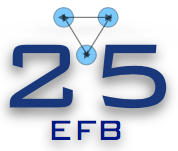Conveners
Tuesday Parallel Session: Few-body systems and hypernuclei (Linke Aula)
- Emiko Hiyama (Tohoku Univ./RIKEN)
Hypernuclear physics is a highly active field in the few-body sector, with significant astrophysical implications, such as in the description of neutron stars. However, hypernuclear systems are more difficult to be studied experimentally than standard nuclei, resulting in a shortage of data for model development and for the fit of realistic hypernuclear interactions. Past models have struggled...
Due to the scarcity of hyperon-nucleon (YN) and the almost lack of hyperon-hyperon (YY) scattering data, hypernuclei with strangeness $S=-1,-2$ are indispensable laboratories to explore the underlying baryon-baryon (BB) interactions. In this work we study s- and light p-shell hypernuclei from a microscopic level employing the ab initio Jacobi no-core shell model (J-NCSM) in combination with BB...
The energy levels of light hypernuclei are experimentally accessible observables that contain valuable information about the poorly known interaction between hyperons and nucleons. In this contribution, I will report on our recent efforts to establish a reliable link between the low-energy properties of hypernuclei and the underlying hyperon-nucleon interactions.
In the first step, we...
The attractive nature of $\bar{K}N$ interaction has stimulated theoretical and experimental searches for $K^-$ bound states in different systems. In particular, many theoretical calculations devoted to the lightest possible system $\bar{K}NN$ were performed using different methods. All of them agree that a quasi-bound state in the $K^- pp$ system exists, but they yield quite diverse binding...
In the no-core shell model, the Jacobi coordinates are often used to describe few-body systems [1]. These coordinates are convenient as they allow the explicit removal of a center of mass coordinate satisfying the requirement of translational invariance within the model space. For the description of the nucleus, the intrinsic coordinates are more natural, as it is independent of the external...

